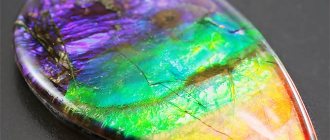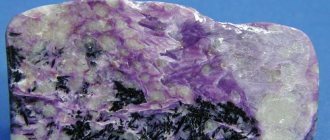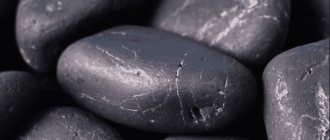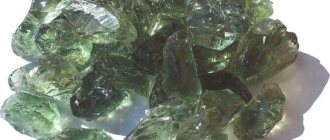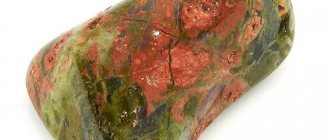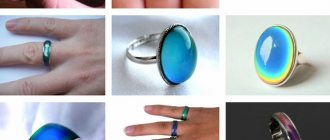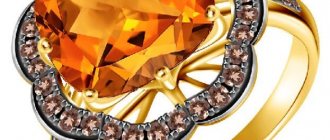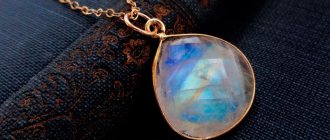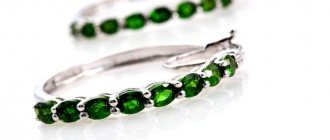If you like minerals that have a green, grassy hue, and are also inexpensive, then epidote stone is ideal.
Sometimes it can be confused with jasper, as there are inclusions of a red tint. But unlike the latter, epidote is a silicate of aluminum, iron and calcium.
In past centuries, epidote has had quite a lot of names. Nowadays, some of the varieties are successfully used in jewelry.
Epidote is little known to a wide range of mineral lovers, but true connoisseurs willingly purchase an unusual stone for their collection.
Today we will study the epidote in as much detail as possible.
Origin story: what kind of stone is this?
For some time, epidote was considered to be a variety of tourmaline. The stone has had dozens of names throughout its history, and its structure has been studied by many luminaries of mineralogy.
Only in 1801, a physicist from France, Hauis, isolated epidote as a separate mineral, which has varieties. You can read about this in the works of the scientist.
Currently, the mineral has been well studied: 300 years after its first discovery, it has fully confirmed characteristics by experts.
This is a complex silicate, which invariably contains a high level of calcium and an alternating content of iron and aluminum impurities.
It has hardness and a characteristic luster in nature and cut, which attracts mineral connoisseurs.
Under different lighting conditions, epidote can change color. And being under the sun's rays it becomes dark, accumulating light in the crystals.
The mineral is formed as a result of changes in rocks during contact metamorphism and in large veins of the Alps.
Untreated crystals are formed correctly, and if they do not have additional impurities, they are characterized by asymmetrical faces.
Epidote is often confused with Vesuvian due to its external similarity and due to its similar color palette.
Epidote family
Epidote is a mineral that creates a whole family circle of similar stones, this row is called the epidote group. In this aggregate, all agglomerates have a similar composition and crystal structure - rhombic and monoclinic. The rhombic system includes only one crystal - zoisite. And the second is much wider and includes clinozoisite, piemontite, allanite, or orthite, and epidote.
Epidote is a mineral that creates a whole family circle of similar stones, this row is called the epidote group
Due to the similar replacement of some components by others, the chemical composition of the stone is very variable. Calcium in the crystal structure can be replaced by magnesium or iron; aluminum can be replaced by manganese, cerium or yttrium. When the volume of manganese in the composition increases, the stone turns into piedmontite, and if the concentration of rarely occurring components increases, then epidote becomes allanite.
Meaning
The name comes from the Greek word epidosis - “increment” or “increase”. The name is given because one of the prismatic faces of the crystal is always longer. English name Epidote.
There are also multiple synonyms that at different times denoted epidote:
- Akantikon;
- Oisanite;
- Dolphinite;
- Tallit;
- Pnetacite (Pistacite);
- Pushkinit;
- Akhmatit;
- Booklandite;
- Esherit;
- Bagrationite.
And some others.
Variety of titles
However, the mineral attracted the attention of other scientists of that time. They studied it, and then almost simultaneously published a description of the stone under their own names.
For example, the German professor Werner in 1803 gave one of the varieties of epidote the name pistacite (from the Greek pistacite - pistachio), emphasizing the pistachio-green color scheme of his sample (pictured below).
It is difficult to determine the priority of any of the researchers. Therefore, some names are still used in mineralogy as synonyms for epidote. One can only imagine how many problems this variety of names for one mineral creates for geology students!
Geologists have identified many varieties of epidote—enough to be called an entire epidote family.
Here is a far from complete list for inquisitive readers of the Encyclopedia of Gems:
- Thallite - Jean-Claude de Lameterie, 1796;
- Oisanite (oisanite) - de Sussy; 1796, after the name of the city of Oisans, (France);
- Arendalite – Karsten, 1800;
- Akanthikone - de Andrada, 1800;,
- Scorza (scorza) - Clapro, (1802).
The variety of forms of epidote crystals and inclusions in its structure led to a further “race of names” for the stone, which researchers mistook for a new mineral. This continued until the second half of the 19th century.
Here are a few more “pitfalls” laid down by past scientists to all subsequent generations of geologists. Let's add a few more names to the list:
- Bucklandite (bucklandite)r – Hermann, (1833);
- Akhmatite (achmatite) - Hermann, (1845);
- Escherite - Scherer, (1855);
- Rosstrevorite - Greg, (1858);
- Bagrationite – Hermann, (1862),
- Beustite or beustite - Breithaupe, (1865).
Physical properties
Epidote crystals emerging from calcite after treating a sample with hydrochloric acid. Maly Kuibas deposit (photo by A. Rechnik)
IMA status – valid, first description before 1959 (before IMA).
Classes according to the taxonomy of the USSR - silicates.
Characteristic:
Physical properties
| Color | Grass green, yellowish green, brownish, green, black |
| Stroke color | Colorless |
| Kink | Conchoidal, splintered, uneven |
| Mohs hardness | 6-7 |
| Transparency | Transparent, opaque |
| Shine | Glass, mother-of-pearl |
| Cleavage | Average by {001}, imperfect by {100} |
| Strength | Fragile |
| Radioactivity | Not detected (only in generation II epidotes, with a high uranium content) |
| Density measured | 3.38 – 3.49 g/cm3 |
| Density calculated | 3,43(3) |
Shape of selection: prismatic; the edges of the prism with hatching, parallel to the c axis. The most common types of crystals are long prismatic, needle-shaped and columnar.
Dissolution in acids is difficult. Under the influence of high temperature, melting begins and a brown-brown magnetic ball is formed. Magnetic susceptibility is weak.
Chemical composition
- Formula: Ca2(A1, Fe)3[Si2O7] [SiO4]O[OH];
- Main impurities: magnesium, aluminum, manganese;
- Molecular weight: 519.30.
Optical properties
- Pleochroism: strong;
- Optical relief: high;
- Type: biaxial (-);
- Refractive indices: nα = 1.715 – 1.751 nβ = 1.725 – 1.784 ny = 1.734 – 1.797;
- Maximum birefringence: δ = 0.019 – 0.046;
- Dispersion of optical rays: strong r > v.
Crystallographic properties
- Syngony: monoclinic;
- Twinning: Lamellar twins intergrown along {100} are common;
- Point group: 2/m – Monoclinic-prismatic;
- Space group: P21/m (P1 1 21/m) [P21/m] {P1 21/m 1};
- Unit cell volume: V 458.73 ų;
- Cell parameters: a = 8.8877(14) Å, b = 5.6275(8) Å, c = 10.1517(12) Åβ = 115.383(14)°;
- Ratio: a:b:c = 1.579: 1: 1.804;
- Number of formula units (Z);
- Class: prismatic (C2h - 2/m (L2PC)).
Additional information: fluctuations in physiological properties are directly dependent on the aluminum and iron content. Ca is constantly present in the composition, but sometimes it is completely replaced by strontium.
Chemical composition
Chemical theoretical composition (at the ratio Fe3+: Al = 1: 2): CaO - 23.04, Al2O3 - 20.32, Fe2O3 - 17.75, SiO2 - 37.04, H2O - 1.85. Epidote includes minerals with the formula nCa2Al3 [SiO4] [Si2O7 ] O (OH)•mCa2Fe3+3 [SiO4] [Si2O7] O (OH), where n is from 90-66% and m from 10-34%, or Ca2Fen3+ Al3-n [SiO4] [Si2O7] O (OH), where 1.00>n>0.1. The final member of this isomorphic series has the formula: Ca2Fe 3 + Al2 [SiO4] [Si2O7] O (OH). All fluctuations in the physical properties of epidote mainly depend on the ratio of Al and Fe3+. The Ca content in epidotes is fairly constant. Epidotes are known in which Ca is partly replaced by strontium. Epidotes usually contain Na and K in small quantities, which also replace Ca. In addition to Fe3+, which replaces Al, epidotes almost always contain Mg, Fe2+, Mn, Ti (usually less than 1% of the corresponding oxides). The existence of magnesium epidote - picroepidote is unreliable, since its chemical analysis is lacking. Some epidotes contain Cr; its content in tavmavite is significant. Epidote from skarn in the Casier area (British Columbia) contains 0.8% SnO2. Some epidotes from skarns contain 0.02–0.07% BeO. The Ural epidote contains up to 1.36% TR2O3, the epidote from the Kola Peninsula contains 2.59-4.57%, and the epidote from Upper Sayan granites contains up to 3.22% TR2O3. The composition of rare earths in epidotes is determined by the environment of mineral formation. These are mainly rare earths of the cerium series. There is data on the content of Ca and Ge in epidotes. In epidote from gold-bearing placers of the Verkhneyvinsky district in the Urals, 0.46% Li2O and 1.67% Na2O were found, which gave Wagner (1841) grounds to distinguish this epidote as a special variety called pushkinite. Repeated analyzes of this epidote were not performed; lithium was not found in other epidotes.
Pushkinit Ural deposit Pervouralskoe.
Accessory epidote from rocks usually contains U and Th. Ural rare earth epidote contains 0.14% U and 0.006% Th.
Forms of location
Stone is a product of alteration of rocks. It can be transparent, translucent or completely devoid of transparency.
It is characterized by metamorphic origin (a common mineral of regional-metaphorical rocks, in the form of skarns and greenschists) and igneous (found in effusive rocks).
It can be found in metamorphic rocks of the amphibolite greenschist facies and albite - epidote - amphibolite subfacies.
Epidote usually has prismatic crystals, elongated along the b axis; in buklandite, they are isometric, tabular along a (100) or c (101).
Heads are formed at one end of the crystal. Drusen can be found where there are heads at the positive and negative ends of the b-axis.
Faces located parallel to the b axis are usually endowed with hatching (horizontal). There is also vertical shading of a rough structure.
The crystals have a twinned shape; they are often columnar, elongated, and prismatic. The aggregates are granular, continuous, parallel-fibrous, radiant.
If the mineral contains less than 5 carats, then it looks almost black, and if it is more than 6 carats, then the color is green, with a soft pistachio tint.
Epidote + other breeds
Often this mineral grows together with other rocks.
The result is very original combinations that have their own characteristics:
- Due to the presence of epidote, granite sometimes acquires a greenish tint. Granite is interesting: in addition to epidote, it contains pink feldspar.
- Crushed quartz, which is “drowned” in epidote, gives birth to Unakite and Epidosite - an attractive material from which jewelry is made.
Unusual combinations are especially appreciated.
Diagnostic signs
Similar minerals Clinozoisite, zoisite, orthite.
By the peculiar yellow-green color, glassy luster, medium cleavage, longitudinal shading of the crystals. It differs from similar chlorite and glauconite in greater hardness, from olivine in color and average cleavage, and from diopside in color and higher hardness.
It differs from clinozoisite in thin sections in its optical sign, higher refractive indices and birefringence; from zoisite - optical sign and birefringence; from orthitis - lower birefringence; from piemontite - pleochroism; from hornblende - higher birefringence and refractive indices, as well as pleochroism; from monoclinic pyroxenes - cleavage, negative optical sign and pleochroism; from Vesuvian - biaxiality; from Hancockite - lower refractive indices
Associated minerals. Garnet, calcite, quartz, diopside, chlorite, amphiboles, magnetite, albite, adularia, apatite, actinolite, pyrite.
Epidote radiant aggregates with calcite and axinite Chukotka
Varieties, colors
The most common color is green, grassy. Shades depend on the presence of various elements. The darker color comes from iron.
The bright greenish-yellow tint is obtained due to the presence of chromium.
Pistachio-colored epidotes are popular, but some people like brownish stones with a red tint.
What are they:
Pushkinit
Chromepidote
Piedmontite
Clinocyositis
Pistacite
Varieties
| Pushkinit | It has a rich dark green color, found in the 19th century. in the southern part of the Urals, discovered by P.I. Wagner. The stones have pleochroism, changing colors at different angles. |
| Chromepidot (tavmavit) | It has a yellowish-golden tone, which provides a high level of chromium. The name is given according to the deposit in Burma. |
| Piedmontite | The mineral contains manganese, so the color becomes reddish. |
| Clinocyositis | The color range can vary from dark green to grayish and green tones. |
| Pistacite | One of the most numerous types, the color is bright pistachio. Due to the similarity in color, epidote is often confused with this mineral. |
Interesting: allanite, named after the discoverer T. Allan, is also known. This mineral is opaque, very dark, almost black. It is radioactive.
Staurolite is often confused with epidote: in thin section the mineral is similar in its “canary” yellowish color with brown and greenish inclusions, but epidote is not so relief.
Description
The classic color of epidote is pistachio. Yellow, gray to black, bottle-green, and brown crystals are common.
The mineral stands out from the general background due to the shape of the crystals. These are prisms with different-sized, asymmetrical faces.
Even pristine nuggets have a glassy luster.
Externally, epidote often looks like the mineral vesuvian, with which it is confused.
Place of Birth
Mining is carried out by open-pit mining using special equipment. The stones are then sorted, ground, polished and the edges smoothed.
In Russia these are the following deposits:
- Ural (Chelyabinsk region, Turin mines);
- Akhmatovsky mines;
- Nazyam and Shishim mountains;
- Irkutsk region;
- Sverdlovsk region.;
- Kemerovo region.;
- Kola Peninsula;
- Kazakhstan;
There are a number of deposits in other countries:
- Brazil (Minas-Geiras);
- Mexico;
- USA (states of New York, Connecticut);
- Norway (Arendal, Kristiansand);
- Australia;
- Canada;
- Finland (Helsinki region);
- Tanzania;
- Ukraine (Volyn region, Zhdilov village);
- Bulgaria (Knyazheva region);
- England (Borowdale);
- Poland (Silesia, Strzegom, former Striegau);
- Italy (from the Ala Valley);
- Germany (Schwarienberg);
- Transcaucasia, Azerbaijan (Dashkesan field);
- Austria (near Salzburg, in Knappenwald, Pfitstahl).
Up to 75% of epidote is found in the Siberian Lowland, in sandy-clayey and clayey rocks. Also found in sedimentary and siltstone.
In the Urals, one of the main deposits, different types of epidote are mined: in the form of small crystals, granular aggregates, dendritic secretions.
Magic properties
The uniqueness of the stone is its ability to help the owner find a lost item. It is enough to hold the mineral in your hands.
Epidote also relieves a person of negative thoughts, anger and irritation, and fatigue.
Properties:
- Gives a state of harmony, success and good luck, especially in financial matters.
- It is recommended for creative people to wear the stone. It can turn a pessimist into an optimist, giving lightness and energy.
- It is advisable for married couples to have a thing made of epidote in the house to strengthen relationships and get rid of emotional wounds.
- Epidote intergrowths with quartz crystals can completely neutralize negative energy in a room.
Medicinal properties
Epidote often serves as a natural healer and assistant for various ailments.
Lithotherapists recommend using the mineral in the following cases:
- For migraines , simply apply the stone to your head and then clean it under running cold water.
- If the nerves are pinched , the mineral quickly eliminates the spasm.
- You can get rid of depression , anxiety and apathy.
- The skin is cleansed , and it is advisable to rinse the mouth with water in which the stone has been in for several hours if you feel unwell.
- If you apply the stone to your chest , arrhythmia and angina will become a thing of the past.
- Epidote is recommended for pregnant women , improves the immune system, eliminates anxiety, brings joy and good mood.
The stone helps with problems with the spine and improves vision. Gives peace and inner harmony. To enhance the impact, it must be worn with silver.
Who is suitable according to their zodiac sign?
It is believed that epidote is a stone of the “air” element, so it is better to wear it specifically for “air” signs: Gemini, Aquarius, Libra , and also Sagittarius .
The mineral is absolutely not suitable for Cancers and Pisces .
Astrological compatibility
The properties of stones are studied not only by doctors and magicians. Astrologers are no less active in this.
(“+++” – the stone fits perfectly, “+” – can be worn, “-” – is strictly contraindicated):
| Zodiac sign | Compatibility |
| Aries | +++ |
| Taurus | + |
| Twins | +++ |
| Cancer | — |
| a lion | + |
| Virgo | + |
| Scales | + |
| Scorpion | +- |
| Sagittarius | + |
| Capricorn | + |
| Aquarius | +++ |
| Fish | — |
- Epidote is considered the stone of Gemini: it protects them from frivolous actions and tells them about those talents that people themselves were not even aware of.
- The gem will help Libra overcome shyness. Gradually, life will be filled with confidence and stability.
- Aries needs a stone to protect them from envious people.
- But experts do not advise Cancers and Pisces to purchase such a talisman: it can have a depressing effect on the body.
- Creative Aquarians with epidote will increase their talents.
- And powerful Leos will be able to direct all their best qualities to achieve career goals.
Is this stone right for you?
Other uses of stone
Small objects made of epidote are especially valued: inkwells, boxes, goblets or even cigarette cases. Each product makes the interior of the room refined and aristocratic. Suitable as a souvenir and gift.
Rare specimens are readily purchased by collectors. Some can cost up to several thousand dollars.
In construction, epidote is often used for floors, countertops and fireplaces.
Prehnite with epidote from Africa is in demand.
How to distinguish a real stone from a fake?
The most common option when a mineral is passed off as epidote is ordinary plastic. But such cases are rare, since epidote is inexpensive.
A real stone has the following properties:
- It is difficult to scratch or chip its surface.
- If you take epidote in your hands, it does not heat up.
Important: plastic is colored evenly, but natural mineral has an asymmetrical color.
Jewelry with mineral
In the jewelry industry, the stone is actively used: it is inserted into rings, earrings and necklaces. Craftsmen try to preserve the natural grace of epidote as much as possible, subjecting it to only minimal processing. For decorations, not all samples are taken, but only those that have an interesting appearance are selected.
Pendant with stone
Transparent crystals are cut, but more often they are still processed as cabochons. After this, the epidote can have a silk or cat's eye effect.
Price and care
Particularly original specimens can be very expensive and are kept in private collections. The rest are quite inexpensive: from 340 rubles. up to 13 thousand rubles. Depending on the cut and quality of the stone, the cost may vary.
Caring for epidote is not at all difficult: it is important not to leave it in direct sunlight, sometimes wash it in a soapy solution and wipe it with a soft cloth. Store in a box.

